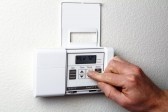 When it comes to heating and cooling your home, you may have discovered several tactics for maintaining your interior temperature and saving on your monthly utility bills. You might keep shutters, blinds, or drapes closed during the day to keep out the sun or add a layer of insulation against cold, winter winds. Perhaps you’ve added energy film that repels heat-producing solar rays. Or maybe you keep the fans running during the summer and throw on sweaters and wool socks when the chilly drafts of winter come to call. You might even use your fireplace once in a blue moon. And of course, you can hire a professional to perform a home energy audit to seal up any leaks that are letting the bought air out. But if you really want to reduce your energy costs, you should be taking advantage of the benefits your programmable thermostat has to offer. Here are a few tips to help you set your system for optimum efficiency and savings.
When it comes to heating and cooling your home, you may have discovered several tactics for maintaining your interior temperature and saving on your monthly utility bills. You might keep shutters, blinds, or drapes closed during the day to keep out the sun or add a layer of insulation against cold, winter winds. Perhaps you’ve added energy film that repels heat-producing solar rays. Or maybe you keep the fans running during the summer and throw on sweaters and wool socks when the chilly drafts of winter come to call. You might even use your fireplace once in a blue moon. And of course, you can hire a professional to perform a home energy audit to seal up any leaks that are letting the bought air out. But if you really want to reduce your energy costs, you should be taking advantage of the benefits your programmable thermostat has to offer. Here are a few tips to help you set your system for optimum efficiency and savings.
Learn how it works. Figuring out how to program your digital thermostat effectively is not terribly difficult, but it may require you to read the directions. Can’t find them? Simply look online for a PDF that matches your system. When you know what all the buttons do and how to use them accordingly, you can set your system to a daily program, or in some cases even a weekly one. And you can always reprogram as needed, say for weekends when you’re home during the day, or when you’re on vacation and the house is empty.
Understand your HVAC system. If you have a fairly modern system, it may have energy-saving features built in. But you have to know how they work if you want to take advantage of them. For example, some AC units come with a 2-step system for energy use. When you turn up the temperature only a couple of degrees, the unit operates in a power-saving mode that requires only a fraction of its potential output. But when you crank the AC it goes into overdrive, drawing a lot more energy. If you know that your system operates in this manner it can help you to set your thermostat to ramp up over time rather than kicking consumption into high gear.
Schedule accordingly. You probably have a pretty good idea of when you’re home and when you’re not, and this can definitely allow you to program different temperatures when you’re present or absent. Optimally, you want the system usage to taper off when the family leaves in the morning and resume about 20-30 minutes before you return at night. Then it should taper off again when you go to bed since you really don’t need it running full blast while you’re under the covers. Remember, you can always override it, say if you stay home sick.
Keep up with changing weather. The weather can definitely play a role in how you heat and air condition your home, so staying up-to-date with changing weather patterns can help you to program your thermostat accordingly.
Perform regular maintenance. Over time, the state of your system not only affects indoor air quality (if you fail to replace filters, for example), but it can also bump up energy consumption and the cost of your monthly utility bills. With regular maintenance you can ensure that your system is ship shape so that when you set your programmable thermostat, it performs at its peak.




2 Comments
If you need a new air conditioner, an energy-efficient one might be eligible for a tax credit (check at http://www.energystar.gov ). When you’re shopping around, look for a unit with a seasonal energy-efficiency ratio of 16 to 21, the highest level of efficiency. Another option is a geothermal heating and cooling system, which uses pipes running from the more stable, ambient temperatures 5 feet underground into your home, where they pump heat in or out, depending on the season.